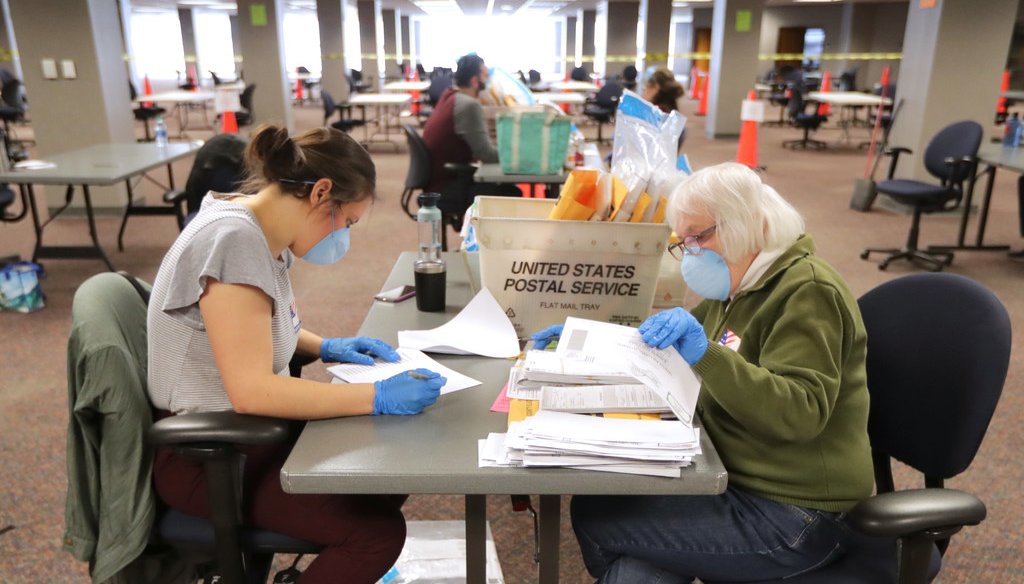Stand up for the facts!
Our only agenda is to publish the truth so you can be an informed participant in democracy.
We need your help.
I would like to contribute

Election officials count ballots in Milwaukee on Monday, April 13, 2020 (Mike De Sisti/Milwaukee Journal Sentinel)
A stark partisan split in how Wisconsinites vote will add some unique twists to an already bizarre election cycle in this battleground state.
Wisconsin drew national headlines for the April presidential primary, where a lack of poll workers left voters standing in line for hours in the state’s largest cities. Milwaukee had just five polling sites available, compared to the usual 180. Green Bay had two instead of the normal 31.
But the state’s Aug. 11 partisan primary — which narrowed the ballot for national and state lawmakers — yields the most interesting foreshadowing for the Nov. 3 general election in a state that experts say could decide the presidency.
That’s because a Marquette University Law School poll conducted in the days before the August election found this:
-
Among people planning to vote in person on Election Day, Donald Trump led by 41 points.
-
Among people planning to vote absentee by mail, Joe Biden led by 67 points.
Barry Burden, director of the Elections Research Center at the University of Wisconsin-Madison, told the Milwaukee Journal Sentinel the August split was likely driven by Democrats who have a greater concern about getting coronavirus, who are also more likely to live in densely populated areas where risks have been higher. That dynamic will certainly remain in November.
This divide has significant consequences for turnout, results and more. Here are a few ways we can expect to see this impact November’s election.
The split means that voting issues that affect one particular means of voting could have a bigger impact on one side than the other.
Mail-in voting is — as expected — unprecedented, with 1.3 million absentee ballots requested as of Oct. 9. That’s already beyond the 1.28 million total from the April primary, and well above the 900,000 from the August primary. (By comparison 845,000 absentee ballots were cast in the 2016 presidential election.)
But that voting has not been flawless.
In the April primary, 2,693 Milwaukee voters didn’t receive the absentee ballots they requested, and 1,600 ballots in the Appleton and Oshkosh areas were found at a mail-processing center the day after the election. It was unclear what percentage of those had been filled out.
A similar hiccup in a state expected to be a close call could particularly impact Democratic voters.
On the flip side, a surge in coronavirus cases around Election Day could discourage some voters from heading to the polls, where the expected turnout is decidedly more Republican.
As of early October, Wisconsin was a national hotspot for the disease, with the third-highest rate of new cases per capita, according to the New York Times COVID tracker.
In-person voting is relatively straightforward, with election workers on hand to make sure the proper rules are followed and deal with any hiccups to ensure a ballot is properly counted.
Mail-in voting has some inherent risks, however. Studies have repeatedly shown it to be safe from fraud, but there are many chances for errors to be made without correction. Absentee ballots must include a voter and witness signature, and they must be returned in time. Failure on any of those points means a ballot won’t be counted.
And that return deadline remains in flux in Wisconsin. One federal judge ruled Sept. 21 that absentee ballots would be counted as long as they are postmarked by Election Day, but an appeals court ruled Oct. 8 the ballots had to be received by Election Day. That ruling may be appealed. A similar battle in April went to the U.S. Supreme Court.
All of this, of course, is expected to have an outsized influence on Democratic voters.
This split also means votes will be reported unevenly from a partisan perspective. The in-person votes are tallied faster, meaning Republicans could look good — inaccurately so — shortly after polls close, before the absentee tallies are added in.
This has been a growing phenomenon in recent years, leading some analysts to dub it the "blue shift."
This delay in Democratic tallying is particularly problematic since Trump has railed against the legitimacy of mail-in ballots, claiming without evidence the system is ripe for fraud. An early Republican lead that ebbs away over time will play into that narrative even if those late votes are legitimately cast and predictably left-leaning.
"It just looks suspicious, and if there’s already hostility between the parties and a lack of trust in authorities and in systems, then it’s easy to jump to the conclusion that somebody is messing with the system (in a way) that is unfair, that it’s being rigged," Burden told the Journal Sentinel.
Our Sources
Milwaukee Journal Sentinel, Another fraught party divide in Wisconsin: most Republicans plan to vote in person, most Democrats by mail, Aug. 12, 2020
Marquette University Law School Poll, New Marquette Law School Poll finds Biden holding a steady lead over Trump in Wisconsin, Aug. 11, 2020
Wisconsin Election Commission, Absentee Ballot Report - November 3, 2020 General Election, Oct. 9, 2020
Wisconsin Election Commission, Absentee Ballot Report - April 7, 2020 Spring Election and Presidential Preference Primary, April 21, 2020
Wisconsin Election Commission, Absentee Ballot Report, Nov. 14, 2016
New York Times, Covid in the U.S.: Latest Map and Case Count, accessed Oct. 9, 2020
Milwaukee Journal Sentinel, Judge gives Wisconsin voters more time to return absentee ballots, Sept. 21, 2020
Milwaukee Journal Sentinel, In reversal, court says Wisconsin absentee ballots must be returned by Election Day, Oct. 8, 2020
The Atlantic, The ‘Blue Shift’ Will Decide the Election, Aug. 10, 2020














































